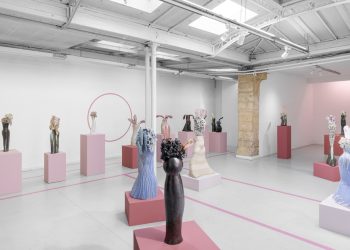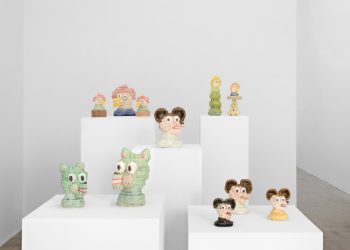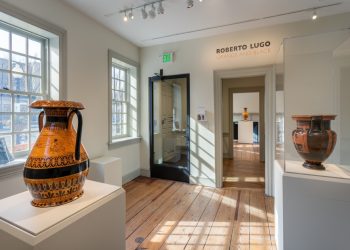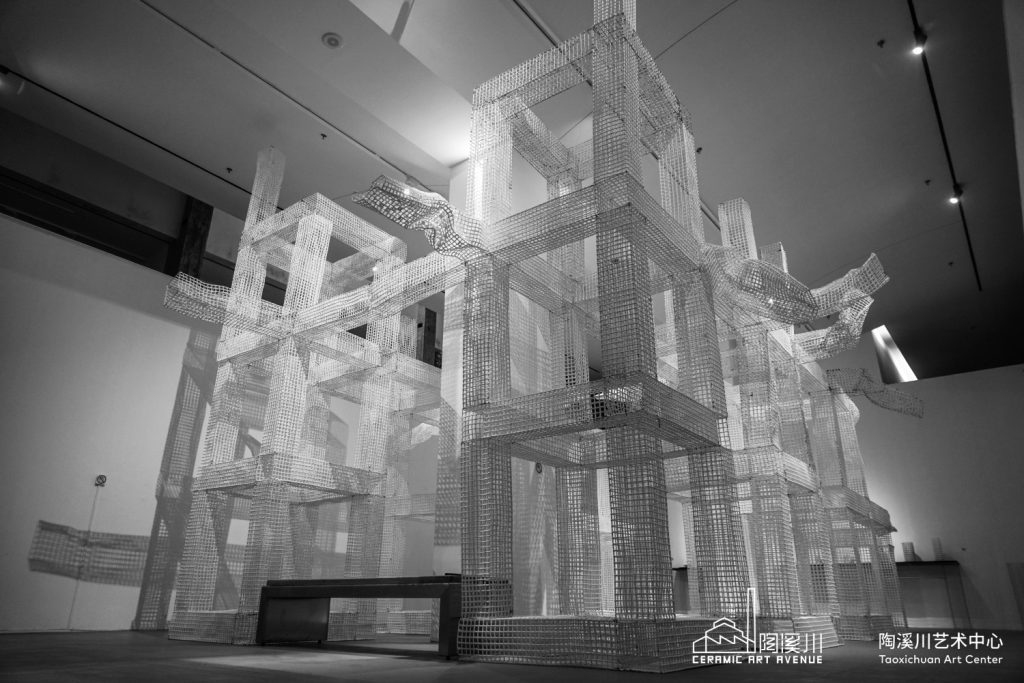
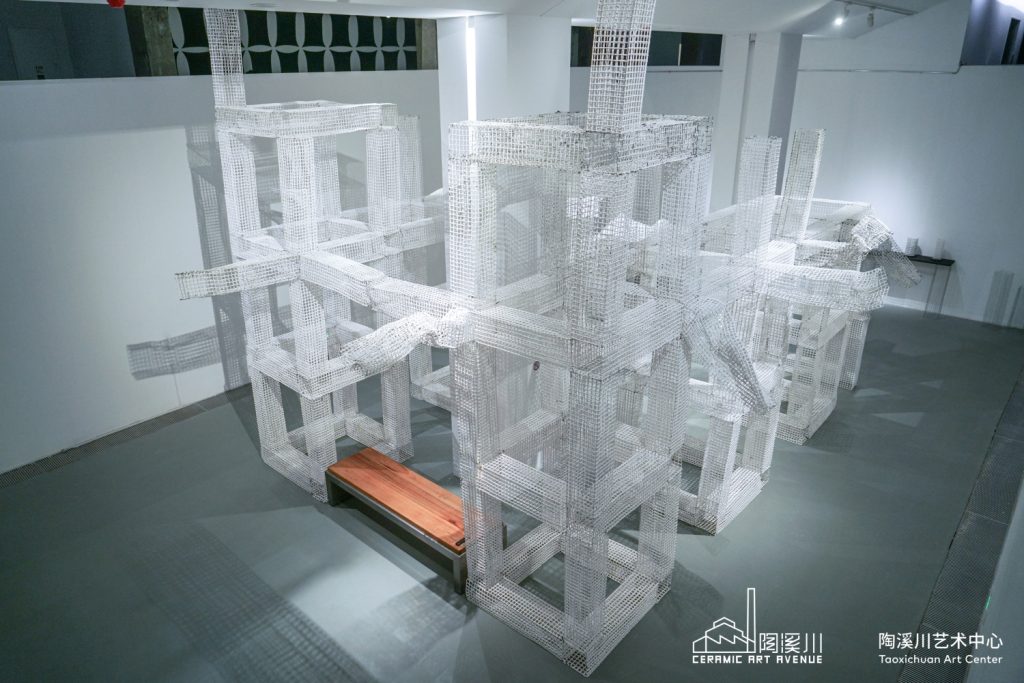
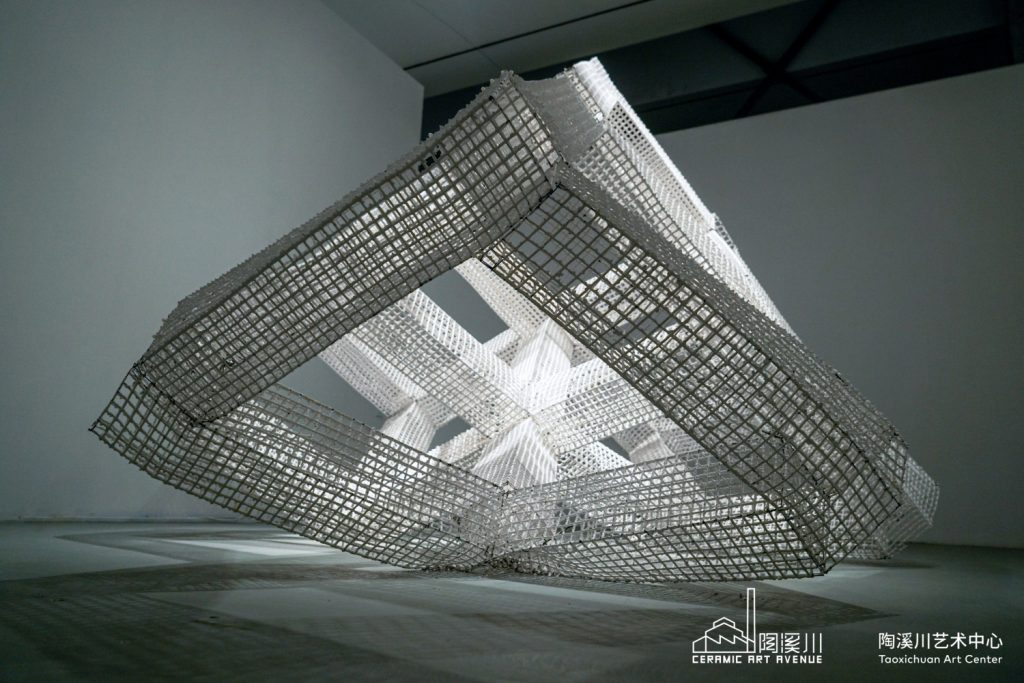
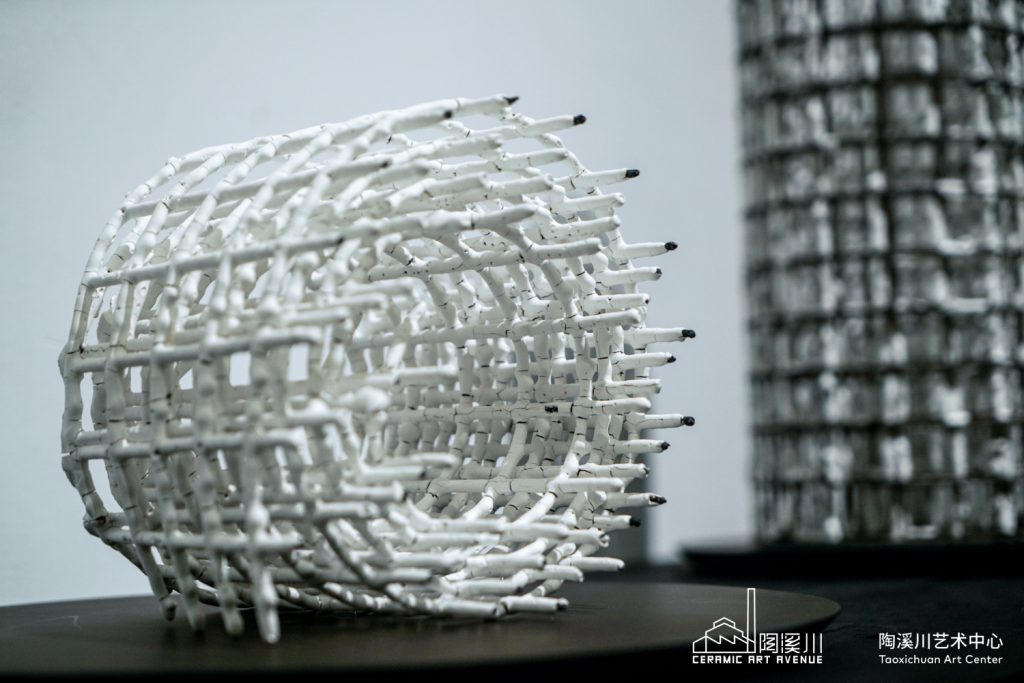
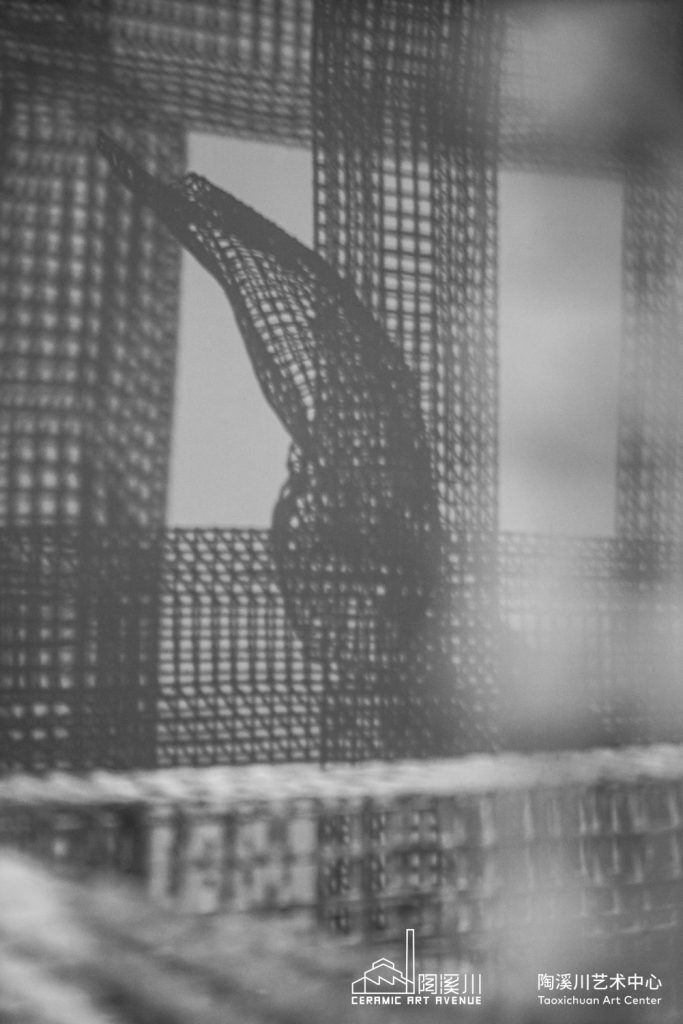
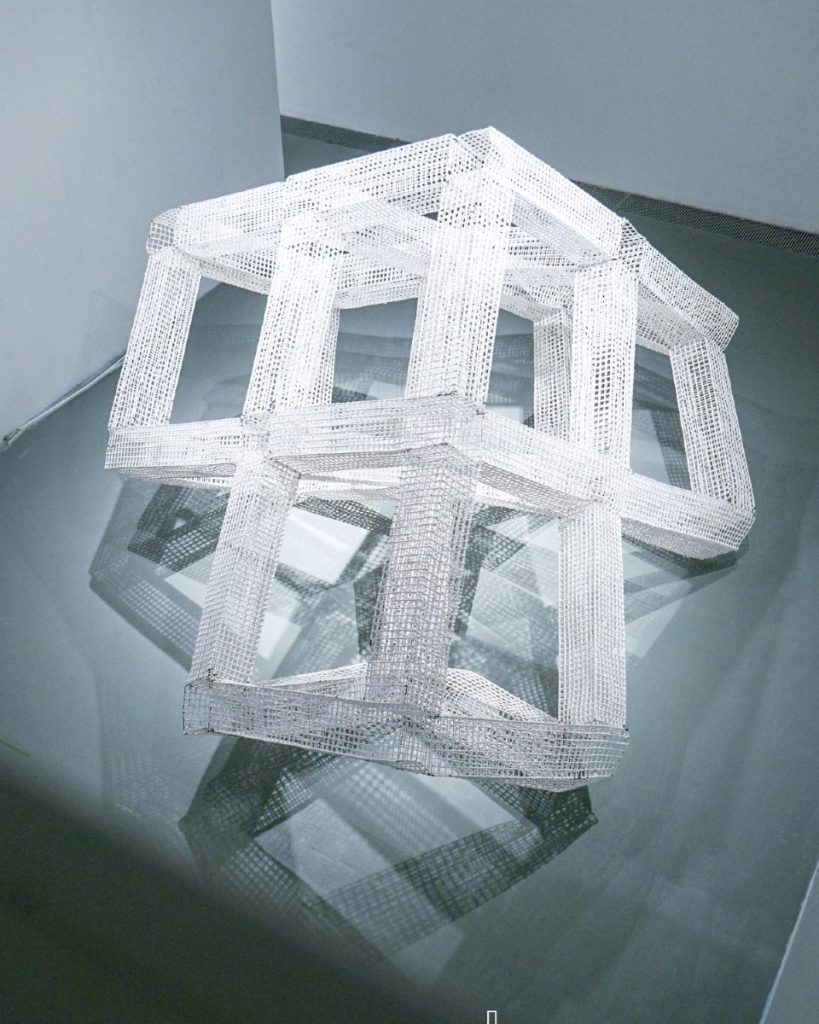
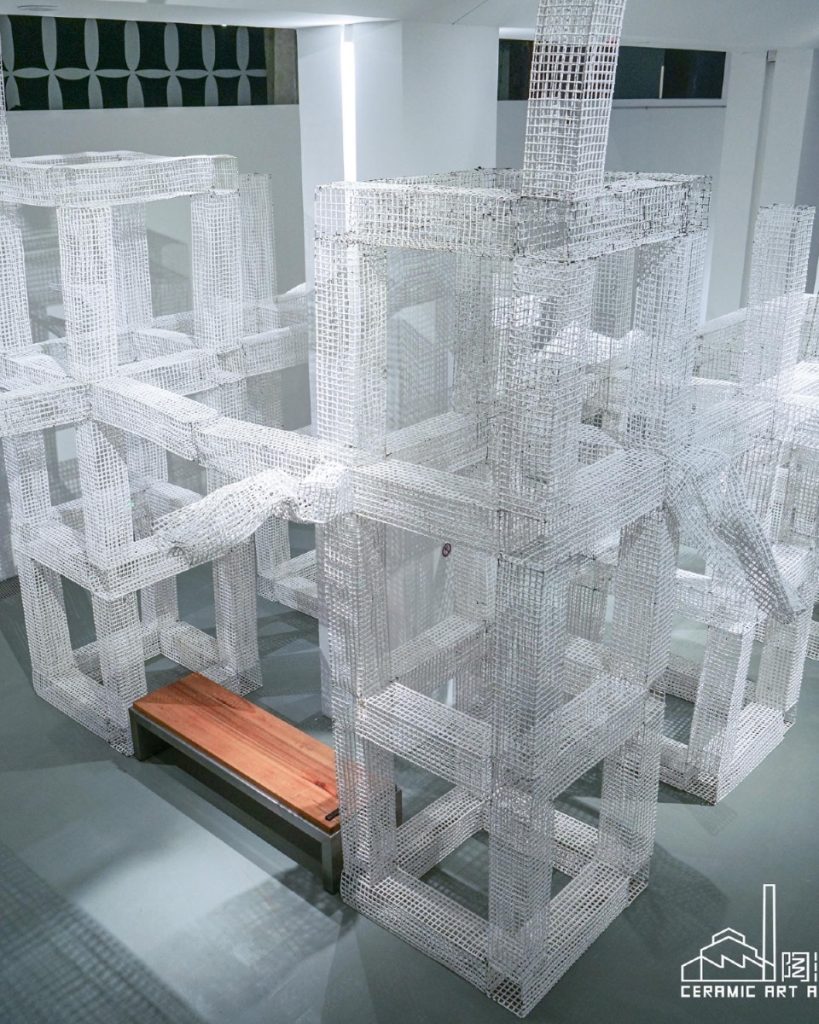
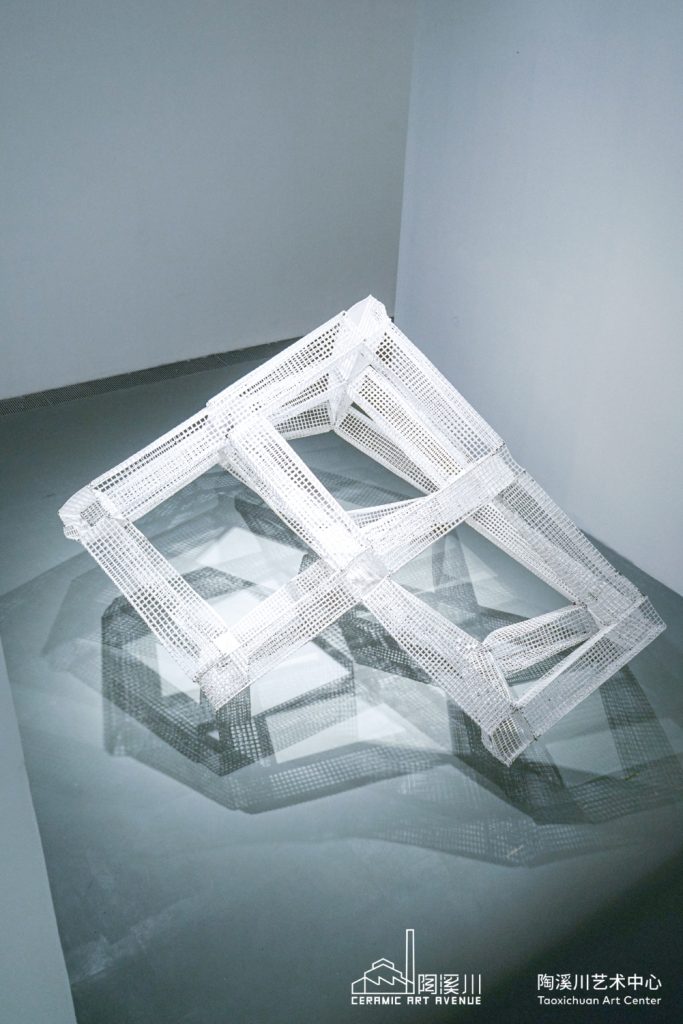
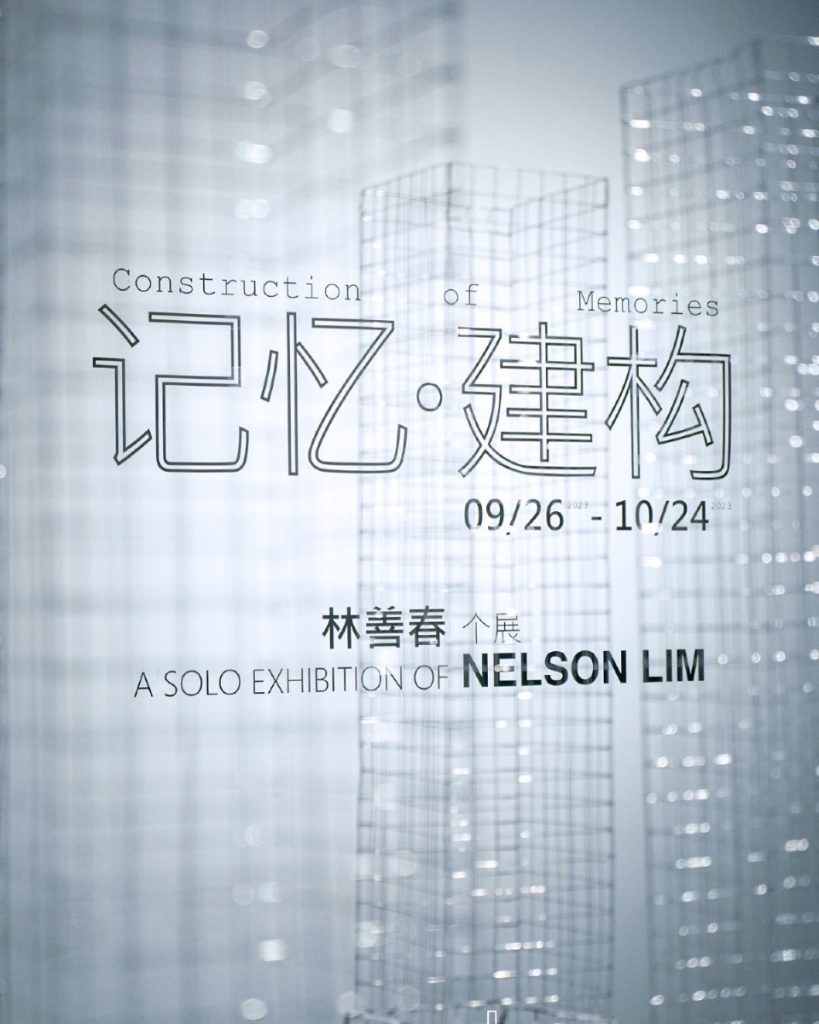
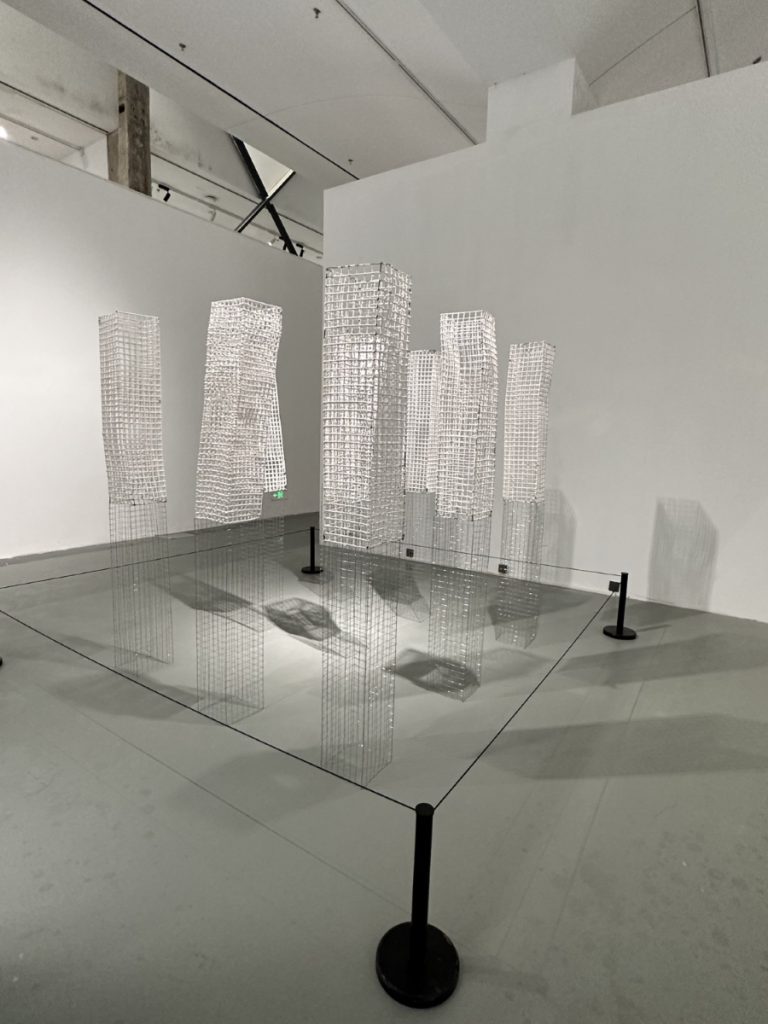
Nelson Lim: Construction of Memories is on view at Taoxichuan Art Center, Jingdezhen
September 26 – October 24, 2023
Dilemma Relationship: Exploring the Intersection of Ancient and Industrial Materials
In my artistic practice, I delve into the intricate and nuanced relationship between two contrasting materials: metal wire, a by-product of the Industrial Revolution (IR), and clay, one of the most ancient materials known to humankind.
Through my research on the production of metal wire, I have gained profound insights into the extensive mechanization involved in its creation. From the melting of metal into threads to the weaving of wire mesh, each step relies on machines and industrial processes.
The advent of the Industrial Revolution brought about significant transformations, leading to the decline of traditional handicraft industries. The ceramics sector, in particular, faced considerable challenges as mass production factories gradually replaced the skilled craftsmanship of individual ceramic artists.
In my work, I intentionally combine these two seemingly disconnected materials by enclosing the metal wire within the clay. Can an ancient material encompass the very material that sparked a movement that threatens to replace it?
On the Edge: Embracing Serendipity in Material Encounters
During the experimental stages, I encountered the challenge of balancing the high firing temperatures, as the metal structure consistently collapsed beyond my control. The porcelain slip that enveloped the metal wire would melt, exerting force as it sought to break free from within, resulting in captivating surface cracks on the artwork. Through countless tests and experiments, I have honed my understanding of the technical aspects of the materials at play. I now strive to meticulously manipulate the shape of the structure and the thickness of the porcelain slip, aiming to achieve my desired effects. However, there are instances when the fusion of these two materials still succumbs to collapse, often due to a mere few degrees Celsius difference.
Industrial Revolution and Its Resonance in Contemporary Existence
The Industrial Revolution has irrevocably shaped every facet of our lives, from our consumption patterns to our living and working environments. Even in the 21st century, we find ourselves immersed in an ongoing era of industrial evolution. Drawing on this metaphor, I pose the question: Can we truly control the environments in which we live? If not, do we, like the structures in my work, melt and collapse under the weight of external forces?
Moreover, in this ever-evolving landscape, the integration of artificial intelligence (AI) has brought about profound changes to our lives. AI has permeated various domains, revolutionizing industries, enhancing efficiency, and transforming the ways in which we interact with technology. From advanced algorithms that optimize industrial processes to machine learning algorithms that assist in artistic creation, AI has become an indispensable tool in shaping our contemporary existence. It prompts us to reflect on the intersection of human ingenuity and technological progress, blurring the boundaries between tradition and innovation. As we navigate this dynamic relationship between ancient and industrial materials, we must also consider the impact of AI on our artistic expressions and the broader societal implications of its integration.
In the realm of artistic creation, the AI revolution has sparked a fascinating dialogue with clay, one of the most ancient materials known to humankind. As AI algorithms continue to advance, they have ventured into the realm of artistic production, offering innovative tools and techniques for artists to explore. AI-powered software can analyse vast amounts of data, generate intricate patterns, and propose novel design ideas, providing artists working with clay a fresh source of inspiration. The collaboration between AI and clay represents a convergence of the ancient and the futuristic, where traditional craftsmanship meets computational creativity. As artists experiment with AI-assisted techniques in sculpting, moulding, and glazing, they redefine the boundaries of what is possible and challenge the notion of authorship in art. This fusion of AI and clay creates a captivating interplay between human imagination and machine intelligence, raising questions about the role of AI in shaping artistic expression and the continued relevance of traditional materials in an increasingly technologically-driven world.
While the integration of AI with clay opens up exciting possibilities, it also raises concerns regarding the negative impact on traditional craftsmanship and the artistic process. As AI algorithms take on a more prominent role in generating designs and patterns, there is a risk of devaluing the skills and expertise of clay artists. The reliance on AI-generated ideas might undermine the uniqueness and personal touch that artists bring to their work. Additionally, the rapid pace of technological advancements can create a sense of detachment from the tactile nature of clay. The hands-on experience of shaping, moulding, and engaging with the material may be overshadowed by the convenience and efficiency offered by AI tools. Furthermore, the increasing use of AI in the production and replication of ceramic works may raise questions about authenticity and originality, blurring the lines between handmade and machine-made creations. It is crucial to strike a balance between embracing the benefits of AI in clay art while preserving the craftsmanship and artistic essence that has been passed down through generations.
Through my artistic exploration of the juxtaposition between ancient and industrial materials, I aim to spark contemplation on the delicate balance between tradition and progress, control and vulnerability, and the enduring power of materials in shaping our collective narrative.
Preface
Hollowness Under Purification
Text by Professor Chang Ching Yuan
The tug-of-war between education and creativity has been a fascinating battle in Nelson Lim’s life. In past years, he devoted himself to education, benefiting countless art creators. Despite being a professional art educator, his passion for artistic creation has never waned at its core. This can be seen from his recent residency in Jingdezhen’s Taoxichuan, where, temporarily setting aside his role as an educator, he contemplates the purity of his identity as a creator.
The Fusion of Material and Rationality
Considering the development of ceramic art history in Singapore, Nelson Lim holds undeniable significance in the contemporary ceramic art development of Singapore. Facing the contemporary art trend that spans disciplines and media, his decision to re-explore the aesthetics of materiality is bold. When confronted with the inherent characteristics of materials, Nelson Lim, through repeated experiments and attempts, seeks precise creative processes that extend from his own personality. By blending metal and ceramics, materials with deep historical roots, he cleverly presents the possibilities of overlap between craftsmanship and industry, much like the dissolution of metal when heated contrasts with the solidity of ceramics when fired. Contradictory materials in his work generate tension, constructed by the artist himself, providing a space that gives rise to this tension. The finished works contain the collapse after the metal dissolves and the sintering after the ceramics are fired, where industrialization and the laws of nature seem to have completely disappeared, akin to modern humanity’s repeated questioning of its own civilization.
Self-awareness in Space
Creating not only requires mastering techniques through extensive experimentation but also places great importance on the ideas the creator desires to express. Nelson Lim, using traditional craft materials, attempts to engage in a dialogue with the modern evolution within the context of industrial development. He strives to reconnect the relationship between art and people in his creations, elevating the overall challenge faced by ceramic art. Emerging techniques are commonplace in his work, but we can always find concepts like architecture and space accompanying his pieces. In architectural spaces, the presence of humans highlights their functionality. Nelson Lim constructed space, woven from lines, allows viewers to observe the structure from a macro perspective. The dialogue between materials conveys the artist’s micro-level sensations, repeatedly reminding viewers that while rules can be constructed, they may change in different contexts. Therefore, the self-awareness of the creation itself (also known as the motive for creation) is necessary to make us reconsider the existence of humans as subjects, much like the seemingly extremely rational sequence of rules, which only reveals its differences and problem awareness once viewers enter the space.
The Importance of Spatial Construction
With this in mind, I ponder Nelson Lim’s dedicated efforts in creation and material research. Over time, he has not only blended two different vocabularies of materials in his creations but has also used the characteristics of materials to propagate his works in a constructive manner. The emergence of space is no longer a product of a quantitative perspective. Instead, it unfolds as viewers step in, churning and turning their self-awareness from the periphery to the center. The spaces between cavities are spaces, and the spaces between columns are also spaces. Viewers may attempt to grasp the balance within the structure or seek to obtain balance from the structure, but nothing compares to letting go of the existing framework of rational epistemology and returning to experiencing the space constructed by Nelson Lim through pure sensory perception. In this space, there are no complex color distractions; all that remains is a reconsideration after the fusion of material and space.
Nelson Lim Sang Choon is a ceramist from Singapore. With a diploma in fine arts (majoring in ceramics) from the Nanyang Academy of Fine Arts and MFA, (Applied Arts in Ceramics) from National Tainan University of the Arts, Nelson has participated in numerous major exhibitions and interacted with artists to infuse new ideas and techniques in his works.
His tireless work attitude and a never-ending desire to improve have led him to be invited to many exhibitions and overseas residencies. His exhibitions include CERAMITIVITY 2005 NUS, Australia Ceramics Triennial 09 ‘drop off’ show, and South East Asia Ceramics conference 2012, among others. Nelson was also invited to be the advisor for various exhibitions and competitions, such as the Ngee Ann 3D Art Exhibition and Ngee Ann 3D Sculpture Competition.
Nelson’s explorative and inventive technique in ceramics making has gained him much recognition and accolades. His works have been selected for prestigious exhibitions such as the Gyeonggi International Ceramic Biennale 2017 Honorable Mention, Taiwan Ceramics Awards 2017 Finalist, and the 12th International Ceramics Competition Mino, Japan 2021.
In 2018, Nelson was accepted as a member of the International Academy of Ceramics, the only association devoted to the medium of clay that functions on an international level.
Nelson had his first solo exhibition in 2017 at the Yingge Ceramics Museum in Taiwan. His work ‘Construction of Memories’ is the largest ceramics artwork ever exhibited in the Museum to date and received encouraging and positive responses from viewers.
In 2021, Nelson participated in group shows of “Singapore Ceramics Now 2021” at Gillman Barack and “reTHINGing Materiality” at the Nafa Gallery in Singapore. In 2022, Nelson partnered with the SEED the Art Space for his first solo exhibition “STILL” in Singapore.
Through his work, Nelson seeks to push boundaries and explore new ideas in the field of ceramics. He believes that ceramics has the power to transcend language and culture, and hopes to inspire others with his creations.
Contact
taoxichuan@163.com
Taoxichuan Ceramic Art Avenue Art Gallery
Xin Chang Western Road, Zhu Shan District
Jingdezhen, Jiang Xi Province
China



